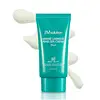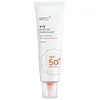What's inside
What's inside
 Key Ingredients
Key Ingredients

 Benefits
Benefits

 Concerns
Concerns

 Ingredients Side-by-side
Ingredients Side-by-side

Water
Skin ConditioningHomosalate
Skin ConditioningEthylhexyl Methoxycinnamate
UV AbsorberEthylhexyl Salicylate
UV AbsorberButylene Glycol
HumectantDiethylamino Hydroxybenzoyl Hexyl Benzoate
UV FilterAlcohol Denat.
AntimicrobialOctocrylene
UV AbsorberPropanediol
SolventBis-Ethylhexyloxyphenol Methoxyphenyl Triazine
Skin ConditioningDicaprylyl Carbonate
EmollientDisiloxane
Skin ConditioningNiacinamide
SmoothingSilica
Abrasive1,2-Hexanediol
Skin ConditioningGlycerin
HumectantHydrolyzed Collagen
EmollientPearl Extract
AntioxidantSea Water
HumectantHydroxypropyltrimonium Hyaluronate
Codium Tomentosum Extract
Skin ProtectingEnteromorpha Compressa Extract
Skin ProtectingLaminaria Japonica Extract
Skin ProtectingSalicornia Herbacea Extract
Skin ConditioningUndaria Pinnatifida Extract
Skin ConditioningHydrolyzed Conchiolin Protein
Skin ConditioningHyaluronic Acid
HumectantCeramide NP
Skin ConditioningPhospholipids
Skin ConditioningPhytosphingosine
Skin ConditioningPhytosterols
Skin ConditioningHydrolyzed Hyaluronic Acid
HumectantSodium Hyaluronate
HumectantPolypropylsilsesquioxane
Ceteth-10
EmulsifyingTromethamine
BufferingAcrylates/C10-30 Alkyl Acrylate Crosspolymer
Emulsion StabilisingCarbomer
Emulsion StabilisingFructooligosaccharides
HumectantSaccharide Hydrolysate
HumectantSodium Acrylates Crosspolymer-2
AbsorbentPullulan
Adenosine
Skin ConditioningEthylhexylglycerin
Skin ConditioningCaprylyl Glycol
EmollientParfum
MaskingHexyl Cinnamal
PerfumingCitronellol
PerfumingAlpha-Isomethyl Ionone
PerfumingGeraniol
PerfumingLimonene
PerfumingLinalool
PerfumingWater, Homosalate, Ethylhexyl Methoxycinnamate, Ethylhexyl Salicylate, Butylene Glycol, Diethylamino Hydroxybenzoyl Hexyl Benzoate, Alcohol Denat., Octocrylene, Propanediol, Bis-Ethylhexyloxyphenol Methoxyphenyl Triazine, Dicaprylyl Carbonate, Disiloxane, Niacinamide, Silica, 1,2-Hexanediol, Glycerin, Hydrolyzed Collagen, Pearl Extract, Sea Water, Hydroxypropyltrimonium Hyaluronate, Codium Tomentosum Extract, Enteromorpha Compressa Extract, Laminaria Japonica Extract, Salicornia Herbacea Extract, Undaria Pinnatifida Extract, Hydrolyzed Conchiolin Protein, Hyaluronic Acid, Ceramide NP, Phospholipids, Phytosphingosine, Phytosterols, Hydrolyzed Hyaluronic Acid, Sodium Hyaluronate, Polypropylsilsesquioxane, Ceteth-10, Tromethamine, Acrylates/C10-30 Alkyl Acrylate Crosspolymer, Carbomer, Fructooligosaccharides, Saccharide Hydrolysate, Sodium Acrylates Crosspolymer-2, Pullulan, Adenosine, Ethylhexylglycerin, Caprylyl Glycol, Parfum, Hexyl Cinnamal, Citronellol, Alpha-Isomethyl Ionone, Geraniol, Limonene, Linalool
Water
Skin ConditioningDipropylene Glycol
HumectantEthylhexyl Methoxycinnamate
UV AbsorberIsoamyl P-Methoxycinnamate
UV AbsorberAlcohol
AntimicrobialStyrene
PerfumingDiethylamino Hydroxybenzoyl Hexyl Benzoate
UV FilterEthylhexyl Salicylate
UV AbsorberNiacinamide
SmoothingC12-15 Alkyl Benzoate
AntimicrobialBis-Ethylhexyloxyphenol Methoxyphenyl Triazine
Skin Conditioning1,2-Hexanediol
Skin ConditioningDimethicone
EmollientHydroxyacetophenone
AntioxidantC10-30 Alkyl Acrylate
Acrylates/C10-30 Alkyl Acrylate Crosspolymer
Emulsion StabilisingSodium Hydroxide
BufferingBetula Platyphylla Japonica Juice
Skin ConditioningSodium Hyaluronate
HumectantMacadamia Ternifolia Seed Oil
EmollientSimmondsia Chinensis Seed Oil
EmollientRosa Rugosa Callus Culture Extract
AntimicrobialLonicera Japonica Flower Extract
Skin ConditioningGlycerin
HumectantSpirulina Platensis Extract
Skin ProtectingLavandula Angustifolia Extract
Skin ConditioningApium Graveolens Extract
Skin ConditioningHyacinthus Orientalis Extract
Skin ConditioningChamomilla Recutita Flower/Leaf Extract
AntimicrobialBarm Extract
Skin ConditioningCentaurea Cyanus Flower Extract
AstringentButylene Glycol
HumectantEthylhexylglycerin
Skin ConditioningCentella Asiatica Extract
CleansingAloe Barbadensis Leaf Extract
EmollientMentha Piperita Leaf Extract
Skin ConditioningEucalyptus Alba Leaf Extract
Skin ConditioningChamomilla Recutita Extract
Skin ConditioningArtemisia Montana Leaf Extract
Skin ConditioningUlmus Davidiana Root Extract
Skin ConditioningPseudoalteromonas Ferment Extract
HumectantYeast Extract
Skin ConditioningPortulaca Oleracea Extract
Skin ConditioningPropolis Extract
Skin ConditioningPanthenol
Skin ConditioningHydrogenated Lecithin
EmulsifyingTocopheryl Succinate
AntioxidantLinoleic Acid
CleansingGlyceryl Oleate
EmollientPyridoxine
Skin ConditioningPolyacrylic Acid
Emulsion StabilisingBiotin
AntiseborrhoeicCyanocobalamin
Skin ConditioningBeta-Carotene
Skin ConditioningSodium Ascorbyl Phosphate
AntioxidantBrassica Oleracea Italica Extract
AstringentLavandula Angustifolia Oil
MaskingRosa Damascena Flower Oil
MaskingOrange Roughy Oil
Skin ConditioningAllantoin
Skin ConditioningXanthan Gum
EmulsifyingPentaerythrityl Tetra-Di-T-Butyl Hydroxyhydrocinnamate
AntioxidantAdenosine
Skin ConditioningDisodium EDTA
Water, Dipropylene Glycol, Ethylhexyl Methoxycinnamate, Isoamyl P-Methoxycinnamate, Alcohol, Styrene, Diethylamino Hydroxybenzoyl Hexyl Benzoate, Ethylhexyl Salicylate, Niacinamide, C12-15 Alkyl Benzoate, Bis-Ethylhexyloxyphenol Methoxyphenyl Triazine, 1,2-Hexanediol, Dimethicone, Hydroxyacetophenone, C10-30 Alkyl Acrylate, Acrylates/C10-30 Alkyl Acrylate Crosspolymer, Sodium Hydroxide, Betula Platyphylla Japonica Juice, Sodium Hyaluronate, Macadamia Ternifolia Seed Oil, Simmondsia Chinensis Seed Oil, Rosa Rugosa Callus Culture Extract, Lonicera Japonica Flower Extract, Glycerin, Spirulina Platensis Extract, Lavandula Angustifolia Extract, Apium Graveolens Extract, Hyacinthus Orientalis Extract, Chamomilla Recutita Flower/Leaf Extract, Barm Extract, Centaurea Cyanus Flower Extract, Butylene Glycol, Ethylhexylglycerin, Centella Asiatica Extract, Aloe Barbadensis Leaf Extract, Mentha Piperita Leaf Extract, Eucalyptus Alba Leaf Extract, Chamomilla Recutita Extract, Artemisia Montana Leaf Extract, Ulmus Davidiana Root Extract, Pseudoalteromonas Ferment Extract, Yeast Extract, Portulaca Oleracea Extract, Propolis Extract, Panthenol, Hydrogenated Lecithin, Tocopheryl Succinate, Linoleic Acid, Glyceryl Oleate, Pyridoxine, Polyacrylic Acid, Biotin, Cyanocobalamin, Beta-Carotene, Sodium Ascorbyl Phosphate, Brassica Oleracea Italica Extract, Lavandula Angustifolia Oil, Rosa Damascena Flower Oil, Orange Roughy Oil, Allantoin, Xanthan Gum, Pentaerythrityl Tetra-Di-T-Butyl Hydroxyhydrocinnamate, Adenosine, Disodium EDTA
 Reviews
Reviews

Ingredients Explained
These ingredients are found in both products.
Ingredients higher up in an ingredient list are typically present in a larger amount.
1,2-Hexanediol is a synthetic liquid and another multi-functional powerhouse.
It is a:
- Humectant, drawing moisture into the skin
- Emollient, helping to soften skin
- Solvent, dispersing and stabilizing formulas
- Preservative booster, enhancing the antimicrobial activity of other preservatives
Acrylates/C10-30 Alkyl Acrylate Crosspolymer is a synthetic polymer. It is used to thicken and improve the texture of products. Due to its properties, it can prevent water and oil ingredients from separating.
Adenosine is in every living organism. It is one of four components in nucleic acids that helps store our DNA.
Adenosine has many benefits when used. These benefits include hydrating the skin, smoothing skin, and reducing wrinkles. Once applied, adenosine increases collagen production. It also helps with improving firmness and tissue repair.
Studies have found adenosine may also help with wound healing.
In skincare products, Adenosine is usually derived from yeast.
Learn more about AdenosineYou might know this ingredient as Tinosorb S or Bemotrizinol. It is a UV filter that covers both UVA and UVB rays.
This ingredient has two peak UV absorption peaks ( 310 and 340 nm) and is able to absorb both UV-A and UV-B rays. This ingredient works by preventing UV rays from reaching and damaging your skin.
On top of that - it is highly photostable and helps prevent the photodegration of other sunscreen ingredients such as avobenzone.
Tinosorb S is allowed in the EU, Australia, and Asia. It is close to being approved by the FDA and we'll hopefully get this ingredient in the U.S. by late 2025.
Fun fact: Tinosorb S is the most effective UV absorber at maximum concentration (measured by SPF) permitted in the EU.
This ingredient is oil-soluble, so your oil-cleansers will take this right off at night.
Learn more about Bis-Ethylhexyloxyphenol Methoxyphenyl TriazineButylene Glycol (or BG) is used within cosmetic products for a few different reasons:
Overall, Butylene Glycol is a safe and well-rounded ingredient that works well with other ingredients.
Though this ingredient works well with most skin types, some people with sensitive skin may experience a reaction such as allergic rashes, closed comedones, or itchiness.
Learn more about Butylene GlycolDiethylamino Hydroxybenzoyl Hexyl Benzoate (DHHB) is a chemical UV-A absorber. It is formulated for high UVA protection (320-400 nm).
DHHB is well-liked for:
DHHB has been approved by the EU, Japan, Taiwan, and South America for use up to 10%. Unfortunately, it has not been approved for use in the US or Canada due to slow regulatory processes.
This ingredient is soluble in oils, fats, and lipids.
Learn more about Diethylamino Hydroxybenzoyl Hexyl BenzoateEthylhexyl Methoxycinnamate is an organic compound that provides UVB protection. It often goes by the more common name of octinoxate. It is created from methoxycinnamic acid and 2-ethylhexanol.
Ethylhexyl Methoxycinnamate absorbs UVB rays with wavelengths between 280-320 nm. UV absorbers protect your skin by using chemical reactions to convert UV rays into heat and energy.
UVB (290-320 nm) rays emit more energy than UVA rays. They are capable of damaging DNA, causing sunburns and are thought to be linked to skin cancer.
The state of Hawaii has banned sunscreens containing octinoxate due to its potential impact on coral reefs. More research is needed to bridge gaps in this research. The European Union allows higher levels of octinoxate in sunscreens than the US and Australia.
Ethylhexyl Methoxycinnamate is oil soluble. It is not stable and may lose efficacy when exposed to sunlight.
Learn more about Ethylhexyl MethoxycinnamateEthylhexyl Salicylate is an organic compound used to block UV rays. It primarily absorbs UVB rays but offers a small amount of UVA protection as well.
Commonly found in sunscreens, Ethylhexyl Salicylate is created from salicylic acid and 2-ethylhexanol. You might know salicylic acid as the effective acne fighter ingredient and BHA.
The ethylhexanol in this ingredient is a fatty alcohol and helps hydrate your skin, similar to oils. It is an emollient, which means it traps moisture into the skin.
According to manufacturers, Ethylhexyl Salicylate absorbs UV wavelength of 295-315 nm, with a peak absorption at 307-310 nm. UVA rays are linked to long term skin damage, such as hyperpigmentation. UVB rays emit more energy and are capable of damaging our DNA. UVB rays cause sunburn.
Learn more about Ethylhexyl SalicylateEthylhexylglycerin (we can't pronounce this either) is commonly used as a preservative and skin softener. It is derived from glyceryl.
You might see Ethylhexylglycerin often paired with other preservatives such as phenoxyethanol. Ethylhexylglycerin has been found to increase the effectiveness of these other preservatives.
Glycerin is already naturally found in your skin. It helps moisturize and protect your skin.
A study from 2016 found glycerin to be more effective as a humectant than AHAs and hyaluronic acid.
As a humectant, it helps the skin stay hydrated by pulling moisture to your skin. The low molecular weight of glycerin allows it to pull moisture into the deeper layers of your skin.
Hydrated skin improves your skin barrier; Your skin barrier helps protect against irritants and bacteria.
Glycerin has also been found to have antimicrobial and antiviral properties. Due to these properties, glycerin is often used in wound and burn treatments.
In cosmetics, glycerin is usually derived from plants such as soybean or palm. However, it can also be sourced from animals, such as tallow or animal fat.
This ingredient is organic, colorless, odorless, and non-toxic.
Glycerin is the name for this ingredient in American English. British English uses Glycerol/Glycerine.
Learn more about GlycerinNiacinamide is a multitasking form of vitamin B3 that strengthens the skin barrier, reduces pores and dark spots, regulates oil, and improves signs of aging.
And the best part? It's gentle and well-tolerated by most skin types, including sensitive and reactive skin.
You might have heard of "niacin flush", or the reddening of skin that causes itchiness. Niacinamide has not been found to cause this.
In very rare cases, some individuals may not be able to tolerate niacinamide at all or experience an allergic reaction to it.
If you are experiencing flaking, irritation, and dryness with this ingredient, be sure to double check all your products as this ingredient can be found in all categories of skincare.
When incorporating niacinamide into your routine, look out for concentration amounts. Typically, 5% niacinamide provides benefits such as fading dark spots. However, if you have sensitive skin, it is better to begin with a smaller concentration.
When you apply niacinamide to your skin, your body converts it into nicotinamide adenine dinucleotide (NAD). NAD is an essential coenzyme that is already found in your cells as "fuel" and powers countless biological processes.
In your skin, NAD helps repair cell damage, produce new healthy cells, support collagen production, strengthen the skin barrier, and fight environmental stressors (like UV and pollution).
Our natural NAD levels start to decline with age, leading to slower skin repair, visible aging, and a weaker skin barrier. By providing your skin niacinamide, you're recharging your skin's NAD levels. This leads to stronger, healthier, and younger looking skin.
Another name for vitamin B3 is nicotinamide. This vitamin is water-soluble and our bodies don't store it. We obtain Vitamin B3 from either food or skincare. Meat, fish, wheat, yeast, and leafy greens contain vitamin B3.
The type of niacinamide used in skincare is synthetically created.
Learn more about NiacinamideSodium Hyaluronate is hyaluronic acid's salt form. It is commonly derived from the sodium salt of hyaluronic acid.
Like hyaluronic acid, it is great at holding water and acts as a humectant. This makes it a great skin hydrating ingredient.
Sodium Hyaluronate is naturally occurring in our bodies and is mostly found in eye fluid and joints.
These are some other common types of Hyaluronic Acid:
Learn more about Sodium HyaluronateWater. It's the most common cosmetic ingredient of all. You'll usually see it at the top of ingredient lists, meaning that it makes up the largest part of the product.
So why is it so popular? Water most often acts as a solvent - this means that it helps dissolve other ingredients into the formulation.
You'll also recognize water as that liquid we all need to stay alive. If you see this, drink a glass of water. Stay hydrated!
Learn more about Water